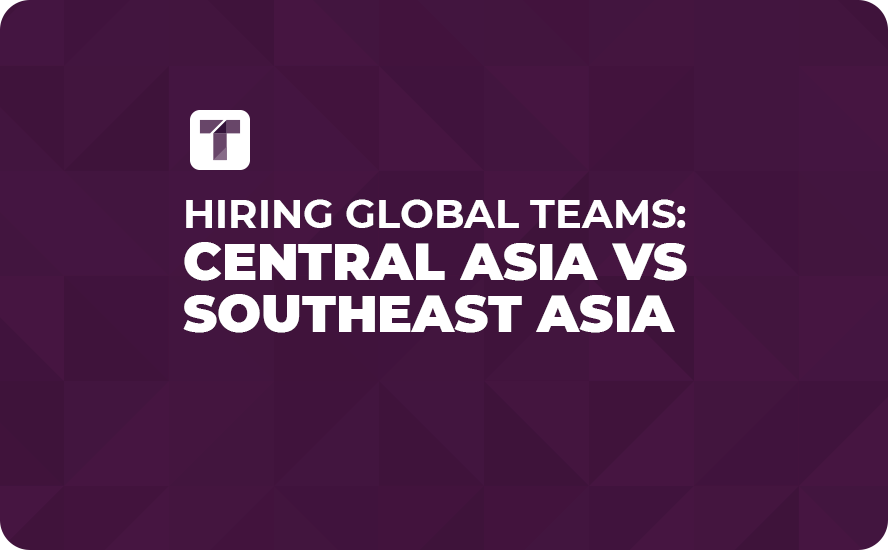In a global economy that is driven by technology and with the advent of the remote workforce many U.S.-based tech companies have begun to recruit software engineers, developers, IT specialists, security analysts, data scientists, systems analysts, administrators, and more in many emerging markets across the globe.
Tech companies who look outside the United States for talent may not know where to start their search – Southeast Asia, South America, Eastern Europe, or India – and many do not know how to start their search. Truss provides tech companies with a global hiring and employment platform with roots in Central Asia that will help you find the perfect fit for your company. When you begin the process, it is important to know where to look and that is where Truss can help the most with a closer look at hiring global teams in Central Asia vs Southeast Asia.
Contact the TRUSS Team today for more information on how to find, recruit, and hire the right tech employees in Central Asia!
Cost of Hiring: Central Asia vs Southeast Asia
Central Asia is an emerging player in the global tech market with countries like Kazakhstan, Uzbekistan, and Georgia leading the way – but how do they compare to countries in Southeast Asia that have a reputation in the tech industry? With lower employment costs, a deep pool of tech talent, large English-speaking populations, and rising interests in the tech industry, countries in Central Asia provide an incredible opportunity for success.
The cost of hiring is a primary concern for tech companies that hope to build their team and hire a remote workforce and this is where Central Asia will stand apart from many regions across the globe. Although estimated annual salaries will vary by source, the combination of talent and cost make Central Asian countries an ideal location to start a remote workforce. Here is a snapshot of estimated software engineer salaries in countries where remote tech jobs are prominent – including in Central Asia and Southeast Asia.
Average Annual Salary for Software Engineers
- United States – $119,000 USD Per Year
- Singapore – $90,018 USD Per Year
- Philippines – $50,000 USD Per Year
- Thailand – $36,156 USD Per Year
- Poland – $62,000 USD Per Year
- Ukraine – $56,000 USD Per Year
- Mexico – $55,000 USD Per Year
- Kazakhstan – $41,600 USD Per Year
- Uzbekistan – $23,728 USD Per Year
- Georgia – $44,400 USD Per Year

Language Barrier: Central Asia vs Southeast Asia
A diverse workforce provides an impressive list of advantages to a global team – but tech companies interested in hiring across the globe want to know that their remote employees will be able to speak English and interact with the team. A growing economy and more and more U.S.-based companies hiring in Central Asia, have led to countries like Georgia, Uzbekistan, and Kazakhstan putting an emphasis on the English language – and many people in the region are bilingual. An estimated 85% of Georgians speak English, 70% of Uzbeks are bilingual with many speaking English, and an impressive 22% of Kazakhs are trilingual. By comparison – an estimated 58% of people in the Philippines, 27% of people in Thailand, and 62.5% of people in Malaysia speak some degree of English.
Tech Talent: Central Asia vs Southeast Asia
When you hire anyone – here or abroad – it is important that you get the best talent available on your team and Central Asia is an emerging market for tech companies who hope to build their team. Like Southeast Asia – Central Asia continues to grow as a hub for tech talent, innovation, and digital information. Located at the intersection of Central Asia and Eastern Europe, Georgia promotes tech careers and provides many educational opportunities for those who hope for a career in the tech industry.
Kazakhstan is a hotbed for tech talent with more than 90% of the population online, government programs to promote tech careers, and a wealth of U.S.-based tech companies investing in its growing economy. Uzbekistan may lead the way for the tech industry in Central Asia with a growing economy, the establishment of the Uzbekistan IT Park, and connections with more than 1,200 tech companies. These factors and many more have created a deep pool of talent in Central Asia that many regions cannot surpass.
How To Hire Tech Talent in Central Asia with Truss?
The benefits of hiring in Central Asia are almost endless – but where do you start? Truss can provide the help you need to find the right fit for your team. Truss has a global team that includes Central Asia and has a keen understanding of the tech industry in the region – which makes the Truss Team uniquely positioned to help you find, recruit, and hire talent in Central Asia.
When you have found the right fit for your team, the Truss platform will help manage onboarding and payroll processes for remote employees, allowing you to focus on business operations. To help you build and create a successful team in Central Asia, Truss has the capability to function as your employer of record in the region and ensure that your company remains compliant with local employment laws and avoids any financial penalties. Tech companies interested in hiring global teams in Central Asia vs Southeast Asia can learn more about the advantages and benefits of choosing Central Asia and the Truss Team with this quick breakdown.
Contact Truss today to learn more about how we can help you hire the right people in the right positions in Central Asia!


